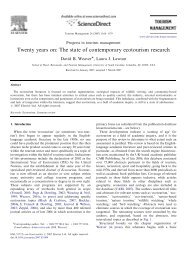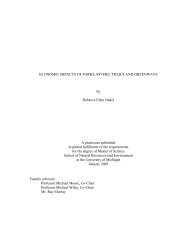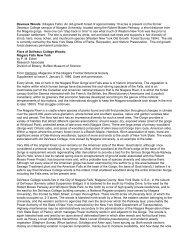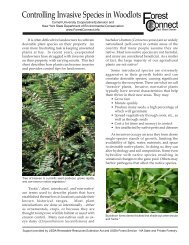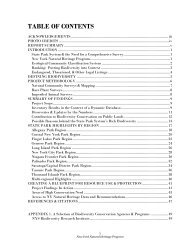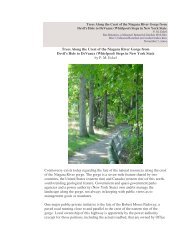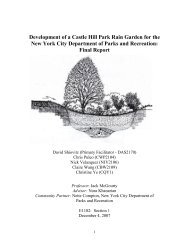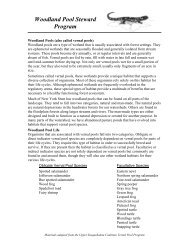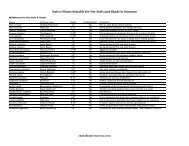Some Remarks on the Socio-Cultural Background of Restoration ...
Some Remarks on the Socio-Cultural Background of Restoration ...
Some Remarks on the Socio-Cultural Background of Restoration ...
You also want an ePaper? Increase the reach of your titles
YUMPU automatically turns print PDFs into web optimized ePapers that Google loves.
<strong>Socio</strong>-<strong>Cultural</strong> <strong>Background</strong> <strong>of</strong> Restorati<strong>on</strong> Ecology<br />
So, restorati<strong>on</strong> ecologists must embrace collaborati<strong>on</strong><br />
with humanities and arts like ec<strong>on</strong>omics, sociology and<br />
landscape architecture in <strong>the</strong> form <strong>of</strong> comm<strong>on</strong> research<br />
and implementati<strong>on</strong> projects. But additi<strong>on</strong>ally, we are<br />
obliged to engage in discussi<strong>on</strong>s to promote <strong>the</strong> acceptance<br />
<strong>of</strong> restorati<strong>on</strong> goals in society. The establishment<br />
<strong>of</strong> an envir<strong>on</strong>ment to provide for future generati<strong>on</strong>s is a<br />
vital task to which restorati<strong>on</strong> ecology makes an important<br />
c<strong>on</strong>tributi<strong>on</strong>.<br />
Acknowledgments<br />
Figure 5. Prerequisites for restorati<strong>on</strong> and management <strong>of</strong><br />
calcareous grassland <strong>of</strong> <strong>the</strong> nor<strong>the</strong>rn Munich Gravel Plain.<br />
are certain prerequisites for <strong>the</strong> success <strong>of</strong> such projects. Here,<br />
<strong>the</strong>se include <strong>the</strong> political will to raise <strong>the</strong> living quality <strong>of</strong> an<br />
area subject to great envir<strong>on</strong>mental pressure, <strong>the</strong> presence <strong>of</strong><br />
suitable farms and agricultural enterprises and <strong>the</strong> proximity to<br />
a prosperous urbanized area.<br />
C<strong>on</strong>clusi<strong>on</strong>s<br />
Is a model like that <strong>of</strong> <strong>the</strong> Munich Gravel Plain transferable<br />
to o<strong>the</strong>r regi<strong>on</strong>s? I do not believe so. Different local<br />
site or land use c<strong>on</strong>diti<strong>on</strong>s and decisi<strong>on</strong> structures require<br />
different local goals and measures. Hence planners,<br />
ecologists, interested people, c<strong>on</strong>servati<strong>on</strong>ists, land<br />
users and o<strong>the</strong>rs must produce <strong>the</strong>ir own local development<br />
c<strong>on</strong>cept, carried out with resp<strong>on</strong>sibility to <strong>the</strong> society<br />
which <strong>the</strong>y represent and with courage, spirit and<br />
intelligence. The implementati<strong>on</strong> <strong>of</strong> restorati<strong>on</strong> projects<br />
is in any event a political task, and will happen <strong>on</strong>ly if<br />
we succeed in c<strong>on</strong>vincing society <strong>of</strong> <strong>the</strong> necessity <strong>of</strong> restorati<strong>on</strong><br />
goals. Just as with architectural m<strong>on</strong>ument<br />
preservati<strong>on</strong>, acceptance is <strong>of</strong> crucial importance.<br />
The analogy between ecological restorati<strong>on</strong> and architecture<br />
has ano<strong>the</strong>r aspect: Ecological restorati<strong>on</strong> is not<br />
<strong>on</strong>ly <strong>the</strong> recovery <strong>of</strong> <strong>the</strong> former state <strong>of</strong> a disturbed or<br />
destroyed ecosystem and its management as an open-air<br />
museum. It also includes <strong>the</strong> c<strong>on</strong>structi<strong>on</strong> <strong>of</strong> new ecosystems,<br />
sometimes with <strong>the</strong> old facade but without its<br />
historical functi<strong>on</strong>. These systems serve as compensati<strong>on</strong><br />
systems in highly industrialized and densely populated<br />
regi<strong>on</strong>s (e.g., newly created wetlands as nutrient<br />
sinks in wastewater treatment and heathlands as recreati<strong>on</strong><br />
areas). Their integrati<strong>on</strong> in new and developing<br />
land use systems is an important prec<strong>on</strong>diti<strong>on</strong> to maintain<br />
<strong>the</strong>ir functi<strong>on</strong>s in <strong>the</strong> l<strong>on</strong>g run. Like new buildings,<br />
<strong>the</strong>y have to fulfill basic functi<strong>on</strong>s and meet <strong>the</strong> aes<strong>the</strong>tic<br />
requirements <strong>of</strong> human beings in order to become m<strong>on</strong>uments<br />
in <strong>the</strong> future worthy <strong>of</strong> protecti<strong>on</strong>.<br />
I am very grateful for <strong>the</strong> invitati<strong>on</strong> and support <strong>of</strong> <strong>the</strong><br />
organizers <strong>of</strong> <strong>the</strong> 2nd Internati<strong>on</strong>al C<strong>on</strong>ference <strong>on</strong> Restorati<strong>on</strong><br />
Ecology held at Gr<strong>on</strong>ingen, Dr. Karl Auerswald<br />
for putting unpublished data at my disposal and my coworkers<br />
for helpful discussi<strong>on</strong>s. The investigati<strong>on</strong>s were<br />
supported by <strong>the</strong> Federal Ministries for Educati<strong>on</strong>, Science,<br />
Research and Technology (BMBF) and for Envir<strong>on</strong>ment<br />
and Nature C<strong>on</strong>servati<strong>on</strong> (BMU), B<strong>on</strong>n, Germany.<br />
LITERATURE CITED<br />
Albrecht, H., and A. Mat<strong>the</strong>is. 1998. The effect <strong>of</strong> organic and integrated<br />
farming <strong>on</strong> rare arable weeds <strong>on</strong> <strong>the</strong> FAM research stati<strong>on</strong><br />
in sou<strong>the</strong>rn Bavaria. Biological C<strong>on</strong>servati<strong>on</strong> 86:347–356.<br />
Anderlik-Wesinger, G., M. Kainz, and J. Pfadenhauer. 1995. Integrierte<br />
Naturschutzplanung auf dem FAM-Versuchsgut Scheyern.<br />
Verhandlungen der Gesellschaft fuer Oekologie 24:507–515.<br />
Auerswald, K., H. Albrecht, M. Kainz, and J. Pfadenhauer. 2000.<br />
Principles <strong>of</strong> sustainable landuse systems developed and evaluated<br />
by <strong>the</strong> Munich Research Alliance <strong>on</strong> Agroecosystems<br />
(FAM). Petermanns Geographische Mitteilungen 144:16–25.<br />
Auerswald, K., W. Flacke, and L. Neufang. 1988. Raeumlich differenzierende<br />
Berechnung grossmassstaeblicher Erosi<strong>on</strong> prognosekarten.<br />
Modellgrundlagen der dABAG. Zeitschrift Pflanzenernaehrung<br />
Bodenkunde 151:369–373.<br />
Auerswald, K., M. Kainz, U. Schwertmann, F. Beese, and J.<br />
Pfadenhauer. 1996. Standards im Bodenschutz bei landwirtschaftlicher<br />
Nutzung das Modell Scheyern. Verhandlungen<br />
der Gesellschaft fuer Oekologie 26:663–670.<br />
Bakker, J. 1989. Nature management by grazing and cutting. Geobotany<br />
14:1–400.<br />
B<strong>on</strong>n, S., and P. Poschlod. 1998. Ausbreitungsbiologie der Pflanzen<br />
Mitteleuropas. Quelle & Meyer Verlag, Wiesbaden, Germany.<br />
Bork, H.-R., H. Bork, C. Dalchow, B. Faust, H.-P. Piorr, and T. Schatz.<br />
1998. Landschaftsentwicklung in Mitteleuropa. Wirkungen des<br />
Menschen auf Landschaften. Klett-Per<strong>the</strong>s, Gotha, Stuttgart,<br />
Germany.<br />
Bradshaw, A. D. 1997. What do we mean by restorati<strong>on</strong>? Pages 8–14<br />
in K. M. Urbanska, N. R. Webb and P. J. Edwards, editors.<br />
Restorati<strong>on</strong> ecology and sustainable development. Cambridge<br />
University Press, Cambridge, United Kingdom.<br />
Bradshaw, A. D., and M. J. Chadwick. 1980. The restorati<strong>on</strong> <strong>of</strong> land.<br />
Blackwell Scientific Publicati<strong>on</strong>s, Oxford, United Kingdom.<br />
Clark, M. J. 1997. Ecological restorati<strong>on</strong>—<strong>the</strong> magnitude <strong>of</strong> <strong>the</strong><br />
challenge: an outsider’s view. Pages 353–377 in K. M. Urbanska,<br />
N. R. Webb, and P. J. Edwards, editors. Restorati<strong>on</strong> ecology<br />
and sustainable development. Cambridge University<br />
Press, Cambridge, United Kingdom.<br />
Eibl-Eibesfeldt, I. 1993. Wir brauchen ein neues Zukunfts-Ethos.<br />
Nature 93:38–39.<br />
228 Restorati<strong>on</strong> Ecology JUNE 2001




